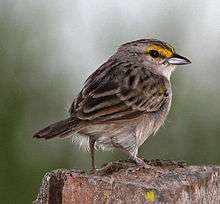Ammodramus
| Ammodramus | |
|---|---|
 | |
| Yellow-browed sparrow (A. aurifrons) | |
| Scientific classification | |
| Kingdom: | Animalia |
| Phylum: | Chordata |
| Class: | Aves |
| Order: | Passeriformes |
| Family: | Emberizidae |
| Genus: | Ammodramus Swainson, 1827 |
| Species | |
|
See text | |
| Synonyms | |
|
Passerherbulus Maynard, 1895 | |
Ammodramus is a genus of birds in the family Emberizidae, in the group known as American sparrows. Birds of this genus are known commonly as grassland sparrows.[1] The name Ammodramus is from the Latin for "sand runner".[2]
These birds live in grassland and marsh habitat. Some Ammodramus are monogamous and both parents care for the young. Other species are polygynous with no pair bonding and no paternal care.[3]
- Seaside sparrow, Ammodramus maritimus
- Dusky seaside sparrow, Ammodramus maritimus nigrescens (extinct, 1987)
- Cape Sable seaside sparrow, Ammodramus maritimus mirabilis
- Nelson's sparrow, Ammodramus nelsoni
- Saltmarsh sparrow, Ammodramus caudacutus
- Le Conte's sparrow, Ammodramus leconteii
- Henslow's sparrow, Ammodramus henslowii
- Baird's sparrow, Ammodramus bairdii
- Grasshopper sparrow, Ammodramus savannarum
- Grassland sparrow, Ammodramus humeralis
- Yellow-browed sparrow, Ammodramus aurifrons
The fossil Ammodramus hatcheri (Late Miocene of Kansas, United States) was formerly placed in genus Palaeospiza or Palaeostruthus. The former may not be a passeriform at all, while the latter was eventually synonymized with Ammodramus, as A. hatcheri scarcely differs from the living species.[5]
References
| Wikimedia Commons has media related to Ammodramus. |
- 1 2 Ammodramus. Integrated Taxonomic Information System (ITIS)
- ↑ Beedy, E. C., E. R. Pandolfino, and K. Hansen. Birds of the Sierra Nevada: Their Natural History, Status, and Distribution. University of California Press. 2013. Page 314.
- ↑ Hill, C. E., & Post, W. (2005). Extra-pair paternity in seaside sparrows. Journal of Field Ornithology, 76(2), 119-126.
- ↑ Ammodramus. Birdlife.org
- ↑ Steadman, D. W., & McKitrick, M. C. (1982). A Pliocene bunting from Chihuahua, Mexico. The Condor, 84(2), 240-241.